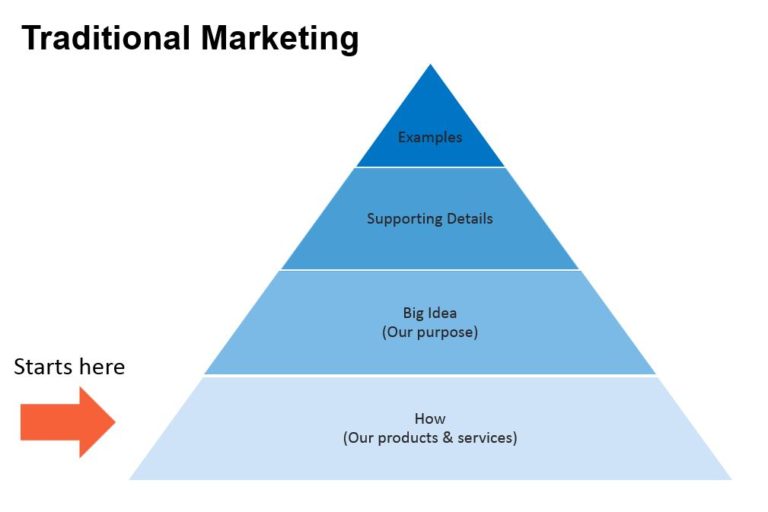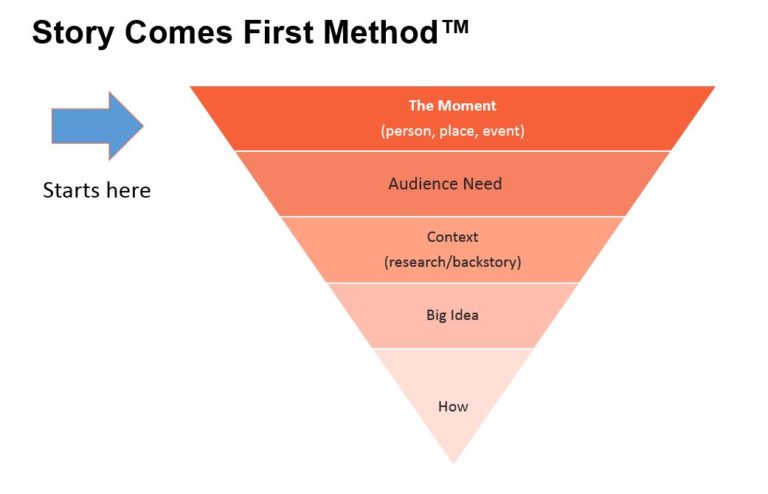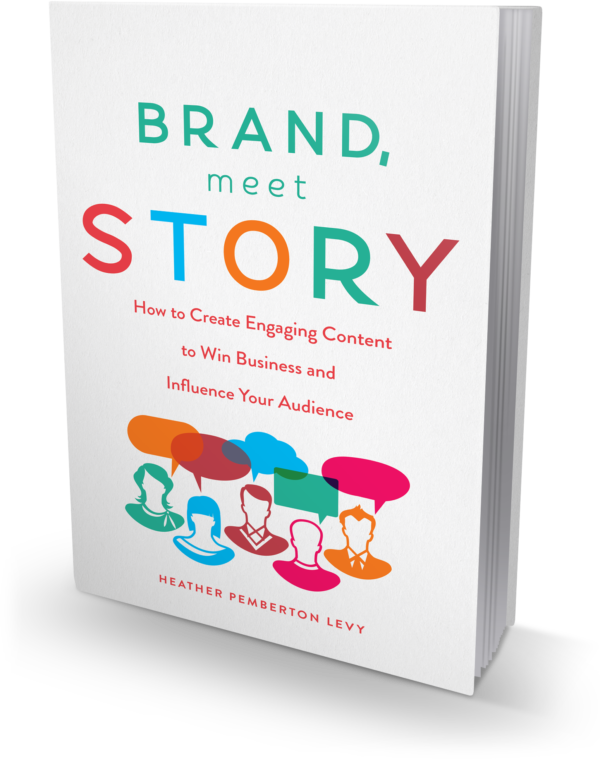
Business photo created by lifeforstock – www.freepik.com
Wish to better capture and sustain your audience attention in content marketing? Start by telling a story!
Make it one that is relevant and compelling to your target customers while addressing their specific pain point.
As a long-time digital marketer, I’ve often wondered how we can marry the worlds of content marketing strategy with brand storytelling.
Thanks to the book Brand, Meet Story: How to Create Engaging Content to Win Business and Influence Your Audience by Heather Pemberton Levy, I learned a revolutionary new way to craft customer-focused content.
In this article, you’ll learn…
- Why traditional brand marketing no longer works
- How you should flip your content to be audience-centric using the Story First technique
- Where stories can be found
- How to identify story moments in your content marketing
How Traditional Marketing Works
Traditional marketing starts by describing how your product or service brand helps your customer.
In content marketing, this may include articles, landing pages, emails, white papers, eBooks, catalogues, and social media posts which covers your product benefits, facts, features and functions.
Next, you have the Big Idea. This could be a description of your company’s brand, goals and values. What made your brand so special? What is its Unique Selling Proposition (USP)?
This is followed by additional details of your product or service—specifications, dimensions, use cases, processes, warranties, and other details. Towards the end, you may append case studies or examples to show how your product or service works.
This would look like a pyramid, as shown by the diagram below:

Courtesy of Story Comes First
Limitations of Traditional Marketing
Sadly, the brand-focused marketing approach no longer works—particularly so in a digital-first world.
Faced with a barrage of content on their smartphones and laptops, consumers only pay attention to content that meet their needs.
This tends to fall into the any of the five Es:
- Educational: Content that teaches them how to be better at what they do, or how they live
- Entertaining: Content that helps them to relax and have fun
- Escapist: Content that helps them to momentary disappear from everyday stresses
- Empathetic: Content that they can connect with, often in the form of stories
- Empowering: Content that makes them feel better about themselves, or which helps to elevate their status
Given this context, self-serving brand-first content often fails to attract attention. Consumers and corporates view them as “product literature” or ads where the only goal is to make money.
Flipping the Pyramid — The Story Comes First Method
Enter the Story Comes First method by Heather Pemberton Levy.
How this works is by starting your entire narrative with The Moment. This is the unique context of product or service use, told in a storytelling fashion.
According to Pemberton Levy, it is “essential to engage your audience by describing what matters to them. Instead of starting with your brand’s message, create a moment that highlights your customer’s challenge or goal. Better yet, use your own personal story to connect with your audience’s struggle or goal.”
Rather than begin with how your product or service works (boring!), you should start by describing that (emotion-filled) moment with your target audience as the protagonist in the story.
Have a look at the infographic below depicting how the reverse pyramid of the Story Comes First method works:

Courtesy of Story Comes First
How the Story First Method Works
Let us step through this framework to see how it works. I’ll include an example so that it’ll be easier to visualise and apply this.
#1 The Moment
Begin by describing the person—either yourself or your target audience as the protagonist—and narrate the exact time, place and event of the story. You should include their struggle and challenges, goal, as well as how they’d use your product or service.
“Tom, we need to talk. Your cash-flow has hit negative for 4 months in a row. At this rate, we’ll be bankrupt in a month.” The news from his accountant hit Tom hard. That was when he decided to turn to us for help in pivoting his business model.
#2 Audience Need
Next, you should describe your target audience’s goals, challenges and needs that relate to the moment. Make it as detailed, vivid and realistic as possible.
A 34-year-old chef and restaurateur, Tom Tan not only loves to cook—he also enjoyed working with people and mingling with his guests. However, when Covid-19 struck, his business suffered greatly. The imposition of social distancing halved his capacity, while his usual office dining crowd started to work from home.
Tom was desperate. He needed a way out.
#3 Back Story/Research
Here, you should describe the specific context for your audience’s need as well as the poignant moment.
Tell the background story. Feature research that supports it. Give references to strengthen your point.
Tom wasn’t alone. When the Coronavirus spread around the globe, it ushered in one of the world’s worst healthcare and economic crisis. Millions of food and beverage businesses around the world suffered greatly due to lockdown measures. In Singapore, sales has dropped by as much as 80 percent for some SMEs.
#4 Big Idea
This is where you define the broader theme which solves your customer’s specific needs. Put them into the right context in the story. Introduce your USP, framework and model.
As a customer-first marketing solution provider, we recommend and implement solutions that consider the 4Cs: Customer, Context, Channels, and Calculation. Our 4C framework examined the situation from a holistic perspective, and recommends practical steps that entrepreneurs like Tom can take.
#5 The How
Here’s where you describe exactly how your product, service, or technology works. You should detail the steps taken in the specific case, and how it meets and exceeds the customer’s needs or helps them to attain their goals.
We recommended a food delivery platform that Tom could subscribe to, enhanced his website for eCommerce capabilities, and strengthened his restaurant’s ability to be found on Google (via SEO). We also updated his social media channels, and launched a Facebook advertising campaign that helped him to reach new customers.
Today, Tom’s diner has managed to become profitable yet again. Business is so good that he is even thinking of hiring new staff—even amidst the Covid-19 pandemic!
Wish to be like Tom? Contact us for a no-obligations chat here: <insert email and contact no>!
(You can download a copy of Heather’s worksheet here.)
Where to Find Customer Story Moments
To uncover these storytelling gems—and bolster your content marketing efforts—consider these strategies:
#1 Interview Your Audiences
This is the best way to get your stories. See if you can speak to both customers and potential customers about how they’d use your product or service.
When doing so, make sure that you get as much crucial details as possible. Such details can make a big difference in the effectiveness of your story.
#2 Use Social Listening Tools
Sometimes, you can unearth customer moments by using social listening tools. Trawl online forums, blog posts, and social media posts with tools like Board Reader, BuzzSumo, Google Alerts, Brandwatch, or others.
You can also participate in Facebook or LinkedIn Groups to monitor the chatter.
#3 Build Use Cases
You can also develop stories based on imagined use cases. This scenarios could be fleshed out based on a day-in-the-life type situations faced by your prospect, as well as your understanding of how they’d interact with your product or service.
Here’s one such example taken from the Story Comes First blog.
“Ruth, a thirty-four-year old mother, frequently asks the digital assistant on her phone for directions to the houses of her children’s friends. While she’s driving, she often remembers items she needs to buy for her family. She’d really like to ask her digital assistant to order more paper towels, laundry detergent, and boy’s tube socks. Her wish isn’t far off. By the end of 2016, more than $2 billion in online shopping will be performed exclusively by mobile digital assistants.”
The Power of Human Moments in Storytelling
Crafting effective stories can make a world of difference in your content marketing efforts.
With the Story First method, your goal is to identify the specific human moments that your product, service, technology or solution helps to make happen.
Spend time to research these moments, flesh them out, and describe them in detail. Make it the first thing which prospects will read in your content pieces—be it a social media post, an email, a blog post, a video, an infographic, or an online ad.
Doing so can help your content to more attractive, more memorable, and more actionable long after they’ve surfed away from your content.
For more insights, go get a copy of the audio book here.

